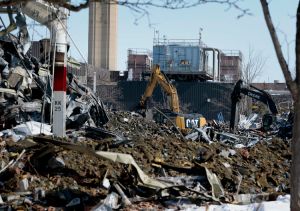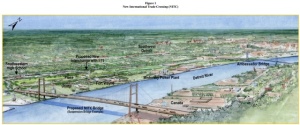For anyone to say we can predict what our economy will be like with any accuracy in 2035 is, speaking frankly, full of it. Looking back at 1995 and comparing to now Windsor, there is no way you would be able to predict our city would look like today. That being said we can look at existing trends and make educated guesses on how our regions economy will progress for the years to come.
Our starting point in 2015 is a mixed bag: the Windsor CMA (includes Tecumseh, LaSalle, Amherstburg and Lakeshore) has the highest unemployment rate in Canada. The city is home to some of the highest concentration of neighbourhood poverty in Canada and 1 in 4 young people will not escape the cycle of inter-generational poverty. On the flip side, a $2 billion overhaul of the Windsor Assembly Plant was just completed which ensures it will remain operational and in Windsor for the near term (5-10 years). We have a new bridge coming, a new Regional Hospital has been unveiled, certain parts of the city are seeing revitalization and growth (Walkerville) and overall the City of Windsor’s fiscal house is in good order and prepared to support economic growth.
Economic Realities
There are three major economic realities facing Windsor’s economy that cast a long shadow over the next 20 years: an aging workforce, the impact of new technology and a lack of economic diversity. The aging workforce is common knowledge and is a challenge that most Western countries face to differing degrees. As baby-boomers retire there will not be enough young people to take their jobs, Statistics Canada is already projecting that 80% of population growth by the 2030s will be driven through immigration. As a result, our local workforce will likely be smaller, more diverse and more prone to manpower shortages in high demand sectors.
The march of technology has of course changed work place. Gone are the days where high paying jobs we waiting for people right out of high school. According to Stats Canada data, Windsor has a higher rate of lower education attainment (high school graduation as the highest level of education achieved) than the provincial average and other communities that we compare ourselves to. If we aren’t breeding the local educated workforce to fill these positions, how can we attract others (businesses or professionals) to our region?
Just up the 401, in London they are grappling with similar issues of economic transformation and its impacts. Mike Moffatt a Professor at the Ivey Business School, Economist with the Mowatt Centre and Policy advisor for Justin Trudeau’s campaign, points out a disturbing trend:
… backed up the worries about jobs with research examining 40 years of employment for men aged 40 to 44.
In 1976, 8 per cent in that group did not have a full-time job.
By 2014, that had more than doubled, with 17.3% of men that age not working full-time.
“If the next 40 years are like the last 40 years — and I think there are very good reasons to believe they will be — this figure could be 30%,…
With an estimated 3 in 10 prime aged male workers expected to be out of full time work over the next 20-30 years, the question has to be asked, why?
The answer is complicated intersection of poor policy choices, increasing productivity, globalization and technological advancement. The impact has been a loss of 300,000 manufacturing jobs in Ontario and according to the Mowatt Centre, these jobs aren’t coming back. For Windsor, the challenge comes from lack of diversity in our economic base with over 16,000 people engaged in manufacturing sector it is by far Windsor’s largest and it is also one of the most vulnerable. The bulk of this manufacturing is situated in the automotive sector, a sector that could be on borrowed time. With no definitive announcements of new products for the Ford Engine plant post-2017 and the trends in investment clearly showing declining competitiveness compared to the Southern US and Mexico it is at least prudent to wonder if Ford and Chrysler will both be operating in Windsor in 2035?
More importantly, how do we transition the 40 something year old assembly line worker to a diversified service and tech economy. We may actually face the prospect of a lost generation but unlike the past where it has been young people moving on to green pastures, it could be mid-aged property tax paying residence. In my opinion we are nearing a tipping point, if we lose our existing base (automotive manufacturing) our community will certainly enter a downward spiral that leads to population contraction and longer term economic malaise.
How to Get Diversification
Economic base theory dictates that every region needs “an item” that it produces and exports to the world. This item can be anything from a physical good whether mined, harvested or manufactured, to a service like health care or financial service or a technological product like apps. For the past 50-60 years that base production has been cars and auto parts, but that is changing. The question is what will that item be in the future?
Economic diversification requires buy-in from our community but the unfortunate reality is that our community seems to have ADD regarding diversification. Over the last half decade that I have been in Windsor, I can recall the following areas being the “catalyst for our economic revival”: Detroit’s revival, aerospace repair, renewable/green energy manufacturing, downtown Windsor revival, sports tourism, a cargo hub at the airport, the automotive sector revival, providing health care for retirees, logistics sector around the new bridge, health care diversification with the new hospital and tech/app start ups.
Although it is good to not put all of our eggs in one basket, each of these strategies have their own advantages and disadvantages as well as resource requirements and support networks. The fact is that any diversification effort needs LONG TERM political and community willpower behind them and the current strategy of pitching an idea, starting it, then moving on hasn’t worked. The shift that we are talking about won’t help this generation of workers in Windsor as a result what is needed is some prioritization.
Unfortunately we only have limited resources as a city/region. Although certain investments are going to happen: Gordie Howe Bridge; a new Mega Hospital (likely); maybe a second private bridge (possibly), but outside of that we need to prioritize where and how should we spend out money? Are we going to be a health care service driven retirement hub for babyboomers or are we going to become a logistics hub for good and services entering Canada/the US or do we venture into a tech driven field supporting software startups?
If we want to become a new Waterloo and feed off of Detroit’s tech sector we have to invest there as a region. The University, the College, the City and County need to decide they want to go that route and then go there. As for figures, we are talking millions of dollars and a decade or more for this transition to occur. It means computer labs in every library and code classes taught to young people; it means hunting down and aggressively incentivizing tech companies (just like we do with manufacturing) to situate themselves here. It means expanding our entrepreneurial ecosystem and ensuring that U Windsor isn’t graduating thousands of students who have little hope of finding local employment. The same type of investments and development would be needed for the health care sector, or the logistics sector or retirement sector but what we need is to decide on what we want to prioritize.
(NOTE: I don’t talk much about Agri-business as I see that as predominately a County industry whether in Greenhouses, Wine or Canning. Although Windsor could move into that area, it would mean competing with the County directly.)
The Outcome
I do not have the answer to what sector is best for Windsor, but what the City and region as a whole are facing a generational transition. The world, the workforce and our region have changed and the pace of this change isn’t going to decrease. New technology is reducing labour requirements in many workplaces and we are long past time when you could walk into a manufacturing plant and be ensured a good paying job for life. Those jobs are being replaced by high trained and skilled individuals which are, in many cases, in short supply in Windsor-Essex.
As this wave of change rushes forward we would be wise to consider the potential economic shocks to our region and we need to be prepared how to transition hundreds, potentially thousands of middle-aged manufacturing employees into new fields or face them leaving the city. Government will remain a driver of growth with health care (hospitals, nursing homes, home care) and the University and College sector remaining major employers but gone will be the days of good jobs for everyone. Outside of those safe sectors something new will be needed whether in tech, health care or service economy to drive employment but they will not employ in the numbers that manufacturing did in the past. Those new jobs will likely come in 10s and 20s and will target those with specific skill sets that are related to the field.
Overall the likely outcome is that Windsor in 2035 will be a smaller city with an economy that is diversified through a viscous cycle of natural selection. In all likelihood, the automotive sector will be long gone leaving behind only those strong and innovative enough to survive. Into that employment vacuum new companies will expand and in all likelihood the community will contract. A smaller community brings both opportunities and challenges for it residence, government and business and the broader impact on the regional economy will be important. What will emerge is a new Windsor that is leaner and meaner than the past.
Fortunately, no one can predict where or when the next billion dollar breakthrough will occur, if it happens and more importantly stays here, the 1600 words above are completely meaningless.


We could easily be in the agri-business in conjunction with the County. WE has some of the best soil and conditions for growing hemp. I believe we can get two crops most years. We have the growing, processing, tooling, manufacturing and distribution experience to be a world leader in this field. Renewable product that can be grown with little to no chemicals, grows well in Windsor, can be used to manufacture everything from clothing to car parts, building materials to bioddiesel and ethanol. Drives me crazy that this area and the Provincial government aren’t seriously looking into this and the government hasn’t made it easy to grow.
I don’t disagree but in the context of the City of Windsor’s 20 year plan it probably doesn’t fit as well as other sectors. To make Agri-business really work we would need a regional context to development that beyond WEEDC doesn’t exist…